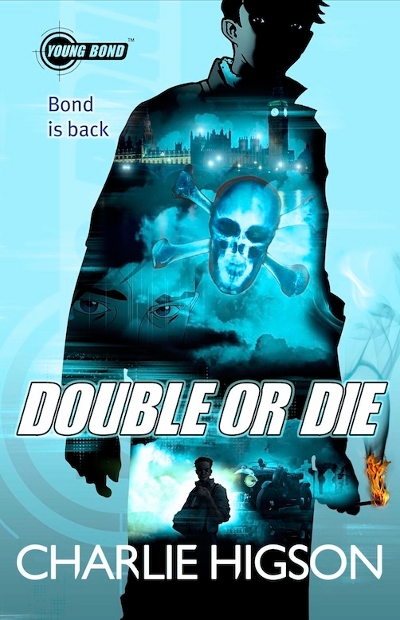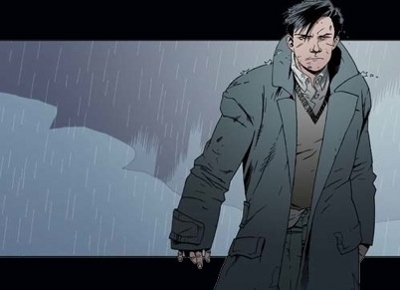|
Double or Die review

Double or Die is the third of
the five Young James Bond novels by Charlie Higson and was published in
2007. The books follow the timeline established by the Ian Fleming
novels written in the 1950s so we are in the 1930s and James Bond is
now fourteen and a pupil at Eton. After his exotic adventure in Blood
Fever, the young Bond is about to be plunged into a most puzzling
adventure that becomes a race against time and is played out in
Blighty. In a North London cemetery, an Eton professor named Fairburn
is kidnapped at gunpoint. Fairburn - a distinguished mathematician -
had left Eton without warning but has sent a letter to Pritpal Nandra,
one of Bond's school friends. The letter is coded and appears to make
no sense but Bond and his friends begin to decipher the letter and
realise that Fairburn is in very big trouble. Not only that, but there
are big ramifications for James Bond and beyond. There are many more
clues to be decoded and understood by Bond and his friends and some
very nefarious characters to be dealt with along the way...
This is a surprisingly
clever third entry in the series and seems to take some of its cues
from The Da Vinci Code (even playing at times like a junior version of
Die Hard with a Vengeance). The book is structured like Fleming's
Moonraker and has more of a real time element and I think it was
thoughtful and interesting the way that Higson set the story in Britain
after the foreign adventure Bond undertook in Blood Fever. One can see
that he is trying to distinguish these books from one another and not
make them all the same and the puzzle solving element to Double or Die
allows for some nice riffs on scenes and situations that occurred in
the Fleming novels. Bond even visits a casino here, a place where he
would be near legendary as an adult for his gambling skills - although
his first assignment in this world involves a game of Hearts. I love
the way he meets an important villain over the game of cards. Very Ian
Fleming. Higson is not Martin Amis and keeps his prose relatively
simple but if one is familiar with the Fleming novels then there is a
hidden layer of enjoyment to be gleaned from his references to those
books and also the way he presents an affectionate take on Fleming's
world and style. The most difficult task the author has with this
series is to make us believe both that Bond had all of these adventures
as a teenager years before he joined the secret service AND that he is
also the same person who grows up to be Fleming's flawed but spiffy
blunt instrument.
The former is the hardest to
digest (rather in the fashion that, for example, it's hard to take the
television series Smallville seriously because we are supposed to
believe Clark Kent had countless adventures and met all of his major
villains before he even became Superman) but Higson doesn't do a bad
job at all. In terms of atmosphere and their relationship to the source
material these are not a million miles away from something like that
Young Sherlock Holmes film. You can sort of believe Holmes had some
notable capers as a youngster before he became a famous consulting
detective and the same is certainly true of James Bond. You can also
increasingly believe that the character in this book really does grow
up to be the James Bond who has all of those famous missions in the
Fleming series. Higson gives Bond an early obsession with death and
mortality, something that of course would never be too far from the
adult Bond's preoccupations given his dangerous line of work. One other
very nice touch is having Bond bored and restless at the start of the
story. Fleming had a word for this ("accidie") and it's a very Bondian
trait. Colonel Sun by Kingsley Amis aside, I've found the James Bond
books written after Ian Fleming's death a struggle at the best of times
and you probably wouldn't have lost an awful lot if some of them didn't
exist but - despite the fact his books are aimed at younger readers -
Higson conveys a better understanding of the world of Ian Fleming and
the character than most of his precessors ever did.

In a sense, Higson has a more
enviable task than John Gardner or Raymond Benson did and is given
(ahem) carte blanche to build the character from the ground up and show
the traits and personality of Fleming's Bond slowly falling into place.
There is even more torture and sadism again (Fleming loved torture and
sadism), Bond this time forced by some baddies to drink copious amounts
of gin. He swears off drinking as an adult, a decent joke as the adult
Bond could probably drink Oliver Reed under the table and still have
room for a nightcap. Higson seems to have upped the violence quotient
here and it's rather bloodthirsty at times, something which I'm sure
younger readers will enjoy. There is a henchman who keeps losing body
parts and all manner of murders and explosions. I think the mist
shrouded graveyard sequence in particular is superbly done and reads
like a tribute to bygone adventure novels. The period setting is
definitely a plus here too. John Gardner and Raymond Benson had to
present James Bond in the eighties and nineties and it's just much more
charming and novel to have him in the 1930s, a decade of course that
Fleming's Bond would have experienced as a schoolboy.
One of Fleming's trademarks was
his habit of inserting factual information of great depth about
whatever was related to Bond's mission. So, for example, in Live and
Let Die, Fleming waffles on about voodoo being the invocation of evil
denizens of the Voodoo pantheon and generally sounds like he's
scribbling from an encyclopedia. It was sometimes fun and sometimes
felt like padding but it did enable to reader and gain a crash course
in whatever Bond was embroiled in, even if it was just his dinner.
Higson does this too in tribute to Fleming and so you get a lot of
information about things like rudimentary computers and London's East
End. Maybe some of these passages could have done with an edit. As
puzzle solving and codes are a big part of the story it's nice to see
Alan Turing get a mention. The use of domestic locations is nicely done
and look out for an old friend from SilverFin making an appearance here
just in the nick of time. I like the way the book is split into three
parts with Fleming-esque chapter titles and Bondian names abound again.
You even get henchmen named Ludwig and Wolfgang. This is an undemanding
but enjoyable read on the whole and another nice addition to the series.
- Jake
c 2013
Alternative 007
|

|


